Everything you need to know about this timeless textile, from ancient origins to modern fashion trends
Table of Contents
- What is Brocade Fabric?
- A Journey Through History
- Brocade in 2025: The Luxury Revival
- Types of Brocade Fabric
- Brocade vs. Jacquard: Understanding the Difference
- How Brocade Compares to Other Fabrics
- How Brocade Fabric is Made
- Properties and Characteristics
- Sustainability and Environmental Impact
- Modern Uses and Applications
- Complete Care Instructions
- Buying Guide and Quality Identification
- Sewing with Brocade
- Cultural Significance Around the World
- Frequently Asked Questions
- Conclusion
What is Brocade Fabric?

Brocade is a richly decorative woven fabric known for its raised, ornamental patterns that appear almost embroidered but are actually woven directly into the material. The name comes from the Italian word “broccato,” meaning “embossed cloth,” and this perfectly describes the three-dimensional quality that makes brocade instantly recognizable.
Unlike printed fabrics or true embroidery, brocade patterns are created during the weaving process using a supplementary weft technique. This means that in addition to the standard warp and weft threads that form the base fabric, extra decorative threads are woven in to create those beautiful raised designs you see on the surface.
What Kind of Fabric is Brocade?
Brocade is a structured, ornamental fabric that belongs to the category of jacquard-woven textiles. It’s characterized by a heavy, luxurious feel and features patterns that stand out from the background fabric. Traditionally made from silk, modern brocade can be crafted from various materials including cotton, polyester, rayon, or blended fibers.
The fabric typically has a distinct “right” side where the pattern looks beautiful and polished, while the back side shows floating threads where the supplementary weft creates the design. This is one key way to identify authentic brocade fabric.
A Journey Through History
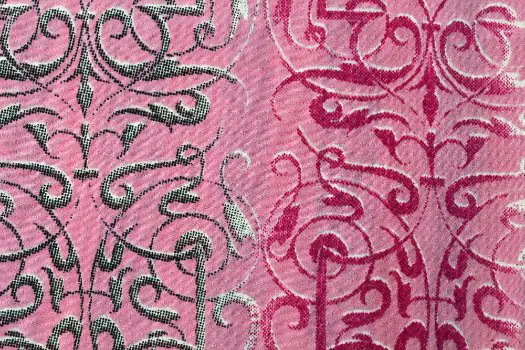
Ancient Origins in China
The story of brocade begins in ancient China during the Warring States period (475-221 BC). Early examples of brocade have been found in burial sites, showing that even thousands of years ago, this fabric was reserved for nobility and people of high status. Chinese artisans kept their silk-weaving secrets closely guarded, making brocade one of the most prized textiles along the Silk Road trade routes.
The Byzantine Era
By the 6th century AD, two monks successfully smuggled the secrets of silk production from China to the Byzantine Empire. This changed everything. Byzantium quickly became a major producer of brocade fabric, and their textiles often featured Christian religious imagery and motifs. Byzantine brocade became the go-to fabric for European royalty and religious leaders throughout the Middle Ages.
Renaissance Italy’s Golden Age
During the Renaissance, Italian cities like Venice, Florence, and Lucca pushed brocade weaving to new artistic heights. Italian weavers created incredibly complex patterns with multiple colors and metallic threads. Many Renaissance paintings show nobles wearing these elaborate brocade garments, preserving the beauty of these textiles for us to see today.
The Jacquard Revolution
In 1804, Joseph-Marie Jacquard invented the Jacquard loom, which revolutionized textile production. This mechanical loom used punched cards to control the weaving pattern, making it possible to create complex brocade designs much faster and with less skilled labor. This invention not only transformed the textile industry but also laid the groundwork for early computer technology.
With the Jacquard loom, brocade production became more efficient and affordable, though it never lost its association with luxury and sophistication.
2025 Market Insights
The global brocade fabric market is projected to reach $1.5 billion by 2025, growing at a 5% annual rate. India and China continue to lead production, while demand is surging in bridal fashion and luxury home decor markets worldwide.
Brocade in 2025: The Luxury Revival
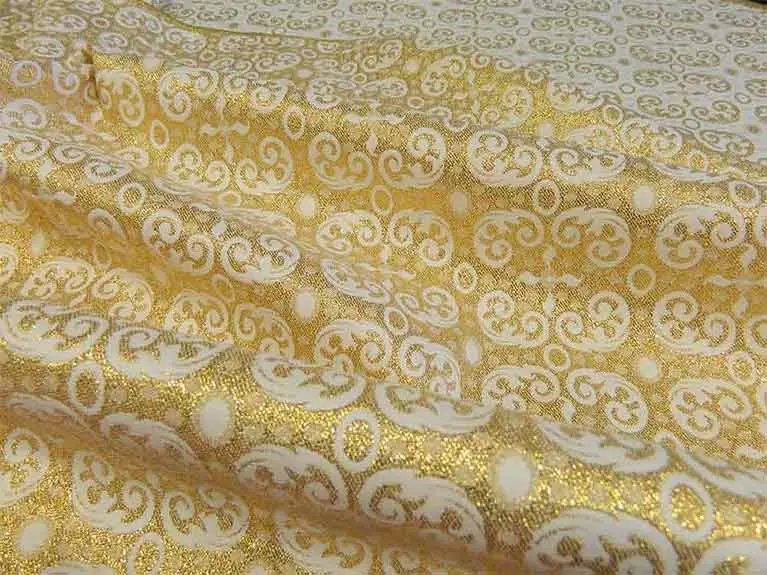
If you thought brocade was just for history books and costume dramas, think again. This fabric is experiencing a major comeback in 2025, and fashion insiders are calling it the year of ornamental textiles.
Why Brocade is Trending Now
Search interest for brocade surged dramatically at the end of 2024 and continues strong into 2025. Several factors are driving this revival:
- Victorian Noir Aesthetic: The dark, opulent, theatrical style dominating runways features brocade heavily, especially in black with metallic accents
- Maximalist Fashion: After years of minimalism, fashion has swung back to bold patterns, rich textures, and statement pieces
- Bridal Market Boom: February 2025 saw search volume for “brocade dress styles” spike to its highest point, driven by wedding season planning
- ’80s Revival: The return of ’80s glamour has brought back metallic threads and structured silhouettes, both brocade specialties
Runway and Designer Collections
Major fashion houses like Saint Laurent and Louis Vuitton have showcased brocade mixed with lace and satin in their recent collections. The fabric is appearing in everything from structured blazers paired with modern cuts to traditional ball gowns with contemporary twists.
Indian fashion is seeing explosive growth in brocade, particularly in fusion wear that combines Western silhouettes with traditional Banarasi brocade fabrics. Gold, maroon, and royal blue dominate the color palette for festive and wedding wear.
Types of Brocade Fabric
Not all brocade is created equal. Different fibers and techniques create distinct types, each with unique properties and price points.
Silk Brocade

The original and most luxurious type, silk brocade offers unmatched softness, smoothness, and natural luster. It drapes beautifully and feels wonderful against the skin. Silk brocade is the top choice for high-end evening wear, wedding gowns, and ceremonial garments. However, it comes with the highest price tag and requires careful maintenance.
Cotton Brocade

More affordable and durable than silk, cotton brocade features subtler patterns and a lighter weight. It’s breathable and easier to care for, making it suitable for both formal occasions and more casual applications. Cotton brocade is particularly popular in India for traditional garments like Jamdani sarees.
Wool Brocade
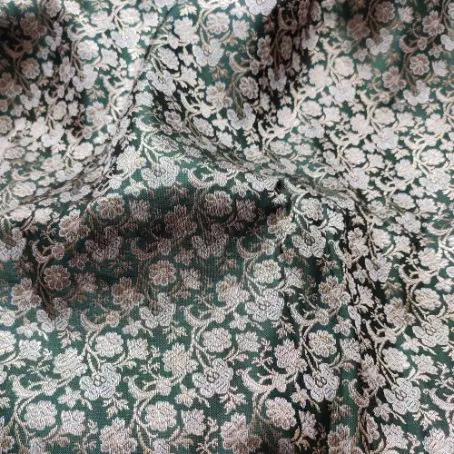
Perfect for cold weather, wool brocade provides warmth along with elegance. It’s commonly used for jackets, coats, and upholstery. The fabric holds its structure well and offers excellent durability, though it requires dry cleaning to maintain its appearance.
Synthetic Brocade
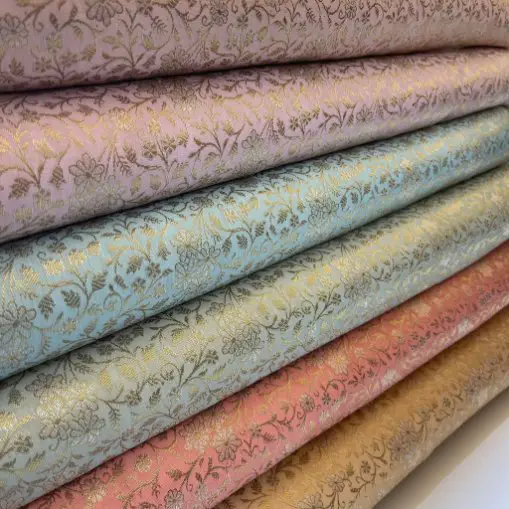
Made from polyester, rayon, or blended fibers, synthetic brocade offers the look of luxury at a fraction of the cost. Modern manufacturing has improved the quality significantly, making synthetic brocade a practical choice for everyday wear, home decor, and costume design. It’s also more resistant to wrinkles and easier to maintain than natural fiber versions.
Zari Brocade

This spectacular variety incorporates metallic threads, traditionally gold or silver, woven into silk or other base fabrics. Originally, real precious metal threads were used, but today most use synthetic metallic yarns that provide the same stunning effect. Zari brocade is central to Indian wedding attire and ceremonial garments.
Regional Specialties
Banarasi Brocade: From Varanasi, India, these brocades are world-famous for their gold and silver zari work, featuring motifs like flowers, leaves, and the iconic Mughal patterns.
Himru Brocade: A cotton-silk blend from India that offers a more affordable alternative while maintaining beauty and durability.
Li Brocade: From China’s Li ethnic minority, this traditional fabric is gaining attention in luxury markets for its unique patterns and 3D weaving techniques.
| Brocade Type | Material | Price Range per Meter | Best Uses | Care Level |
|---|---|---|---|---|
| Silk Brocade | Pure Silk | $50-$300+ | Evening wear, bridal gowns | High (dry clean only) |
| Cotton Brocade | Cotton | $15-$80 | Day wear, traditional clothing | Medium (hand wash) |
| Wool Brocade | Wool | $30-$150 | Winter jackets, upholstery | High (dry clean only) |
| Synthetic Brocade | Polyester/Rayon | $8-$40 | Everyday wear, home decor | Low (machine washable) |
| Zari Brocade | Silk with metallic threads | $80-$500+ | Wedding attire, ceremonies | Very High (professional dry clean) |
Brocade vs. Jacquard: Understanding the Difference
This is one of the most common questions about brocade, and the answer is both simple and complex: all brocade is jacquard, but not all jacquard is brocade.

What is Jacquard?
Jacquard refers to the weaving technique and the type of loom used to create complex patterns. Any fabric woven on a Jacquard loom with woven-in designs (not printed) is technically a jacquard fabric. This includes brocade, damask, matelassé, and other decorative textiles.
What Makes Brocade Different?
Brocade is a specific type of jacquard fabric distinguished by:
- Raised patterns: The supplementary weft creates a three-dimensional, embossed effect
- Decorative emphasis: Often includes metallic threads or contrasting colors for an ornamental look
- Distinct wrong side: The back shows floating threads and looks clearly different from the front
- Heavier weight: Generally thicker and more structured than other jacquard fabrics
Think of it this way: jacquard is the weaving method (like saying “baked goods”), while brocade is a specific result of that method (like saying “croissant”).
| Feature | Brocade | Jacquard (General) |
|---|---|---|
| Pattern Type | Raised, embossed, three-dimensional | Can be raised or flat |
| Texture | Heavy, textured, structured | Varies from light to heavy |
| Wrong Side | Clearly different with floating threads | Often reversible or similar on both sides |
| Common Features | Metallic threads, ornamental designs | Any woven pattern |
| Typical Uses | Formal wear, luxury items | Everything from casual to formal |
| Price Range | Generally higher | Wide range depending on type |
Are Jacquard and Brocade the Same?
No, they’re not the same, though they’re related. Jacquard is the umbrella term for any fabric woven on a Jacquard loom, while brocade is one specific category within that family. Other jacquard fabrics include damask (which we’ll discuss next) and various upholstery fabrics.
How Brocade Compares to Other Fabrics
Brocade vs. Damask

Both are jacquard-woven fabrics, but they have distinct characteristics:
Damask is flatter and typically reversible, with the pattern visible on both sides in opposite colorways. Damask fabrics are commonly used for table linens, upholstery, and curtains. The patterns are woven into the fabric but don’t have the raised, three-dimensional quality of brocade.
Brocade has a clear front and back, with raised patterns that create texture. It’s generally thicker and more ornamental, often incorporating metallic threads. The wrong side shows loose floating threads from the supplementary weft.
Is Brocade the Same as Embroidery?
No, and this is an important distinction. Embroidery is created by stitching thread onto an already-woven fabric using needles. You can feel the stitches on the back, and embroidered designs can be added to any base fabric.
Brocade patterns are woven into the fabric itself during manufacturing. The design is created simultaneously with the base fabric using the loom. While brocade may look embroidered, it’s actually a fundamental part of the textile structure.
What Fabric is Similar to Brocade?
Several fabrics share characteristics with brocade:
- Brocatelle: A heavier version of brocade with even more pronounced raised patterns, often used for upholstery
- Lampas: Features multiple sets of warps and wefts creating elaborate patterns, similar in appearance but with a different weaving structure
- Rich Damask: When damask includes metallic threads, it can look similar to brocade but lacks the three-dimensional quality
- Taffeta with Appliqué: Can mimic the look of brocade but the designs are applied rather than woven
Understanding the differences between these decorative woven fabrics helps you choose the right material for your project.
Brocade vs. Silk
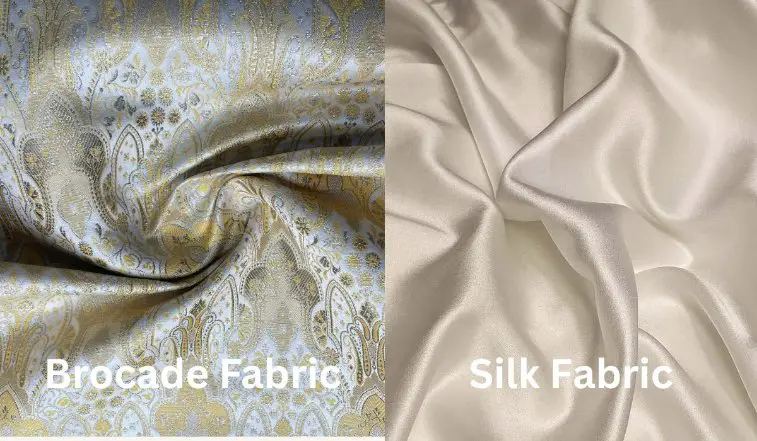
This comparison is a bit like comparing apples to apple trees. Silk is a fiber (the material), while brocade is a weaving technique (the construction method). You can have silk brocade, which is brocade made from silk fibers, or you can have silk in other weave structures like satin, chiffon, or organza.
How Brocade Fabric is Made
Creating brocade is a complex process that combines traditional craftsmanship with modern technology. Let’s break down how this beautiful fabric comes to life.
The Manufacturing Process
- Fiber Selection: The process begins with choosing the right materials. Traditional brocade uses silk, but modern manufacturers also work with cotton, wool, polyester, or blended fibers. The supplementary weft threads (which create the pattern) are often silk, metallic yarns, or synthetic alternatives.
- Design Creation: Today, designers use computer-aided design (CAD) software to create the patterns. The design is converted into a digital file that controls the Jacquard loom. In the past, this step involved creating physical punched cards.
- Yarn Preparation: All yarns are dyed before weaving begins. This is important because the colors need to be exact before they’re woven together. The yarns are also treated to ensure proper tension and strength during weaving.
- Loom Setup: The warp threads (running lengthwise) are loaded onto the Jacquard loom. The loom is programmed with the design pattern, which controls which warp threads lift up at each point in the weaving process.
- Weaving: The base fabric is created first using the regular warp and weft threads. Then, as the weaving progresses, the supplementary weft threads are introduced only where the pattern requires them. This is what creates those beautiful raised designs. The Jacquard loom controls exactly which threads go where, allowing for incredibly complex patterns.
- Finishing: After weaving, the fabric may undergo finishing treatments. This can include steaming to set the pattern, brushing to enhance texture, or applying protective treatments. Some brocades receive a glazed finish for extra sheen.
Traditional vs. Modern Methods
Traditional hand-loom brocade, still produced in places like Varanasi, India, requires exceptional skill. A master weaver and an assistant can take weeks or months to create just a few meters of elaborate brocade.
Modern computerized Jacquard looms can produce brocade much faster while maintaining quality. However, the finest brocades still command premium prices because of the expensive materials and specialized knowledge required. For more details on brocade manufacturing processes, textile professionals often reference comprehensive fabric directories.
Properties and Characteristics
Understanding brocade’s physical properties helps you know what to expect when working with or wearing this fabric.

Key Characteristics
Weight and Structure: Brocade is typically heavy and stiff compared to other fabrics. This gives it excellent structure, making it ideal for garments that need to hold their shape, like jackets and formal gowns. The weight varies depending on the base material and pattern complexity.
Texture: The fabric has a distinctive dual texture. The base is usually smooth (often satin or twill weave), while the raised pattern areas have a tactile, three-dimensional quality. This contrast is one of brocade’s most appealing features.
Durability: Thanks to its tight weave and thick construction, brocade is quite durable. It resists pulling and tearing better than many decorative fabrics. However, the edges can fray easily if not finished properly.
Stretch: Brocade has minimal to no stretch. The tight weave and supplementary threads make it a very stable fabric. This is great for structured garments but means brocade clothing needs to fit well since it won’t give.
Breathability: Most brocade, especially the heavier varieties, is not very breathable. The dense weave and multiple layers of thread trap heat, making it better suited for cooler weather or air-conditioned environments.
Luster: Natural brocade, particularly silk varieties, has a beautiful natural sheen. When metallic threads are incorporated, this shine becomes even more pronounced. The raised patterns catch light differently than the background, creating a dynamic visual effect.
Drape: Brocade typically has a stiff drape. It doesn’t flow softly like chiffon or georgette. Instead, it holds its shape, creating crisp lines and sculptural silhouettes.
Advantages of Brocade Fabric
- Luxurious appearance that stands out
- Excellent for structured, formal garments
- Durable and long-lasting when properly cared for
- Holds shape well without sagging
- Available in wide range of designs and colors
- Can be made from various fibers to suit different budgets
- Less likely to wrinkle due to its stiffness
Disadvantages of Brocade Fabric
- Limited stretch makes fitting more challenging
- Can be uncomfortable in hot weather due to poor breathability
- Edges fray easily and require careful finishing
- Higher-end varieties are expensive
- Requires special care (often dry cleaning)
- Heavy weight can be tiring to wear for long periods
- Not suitable for casual, draped styles
- Can be difficult to sew for beginners
Is Brocade Warm?
Yes, brocade generally provides good warmth. The thick, densely woven structure traps body heat effectively. Wool and silk brocade are particularly warm, making them excellent choices for fall and winter garments. However, this also means brocade can be uncomfortable in hot weather.
Is Brocade a Winter Fabric?
While brocade is often associated with cold weather because of its weight and warmth, it’s not exclusively a winter fabric. Lighter cotton or synthetic brocades can work in milder weather. The key is choosing the right weight and fiber content for your climate.
Can Brocade Be Worn in Summer?
Yes, but with caution. Choose lightweight cotton or silk brocade and limit wear to air-conditioned indoor events. Avoid heavy brocade or synthetics in summer heat. Indian summer weddings often feature lighter-weight brocade with breathable linings to make the fabric more comfortable.
Is Brocade Comfortable to Wear?
Comfort depends on several factors. The fabric itself is relatively stiff and can feel restrictive compared to stretchy or flowing materials. However, when properly fitted and lined with softer fabric, brocade garments can be comfortable for special occasions. Natural fiber brocades (silk, cotton) are more comfortable than synthetics because they allow some air circulation.
Is Brocade Waterproof?
No, brocade is not waterproof. In fact, exposure to water can damage the fabric, especially silk brocade. The metallic threads in zari brocade can tarnish when wet. If your brocade garment gets wet, blot it gently and allow it to air dry away from direct heat.
Sustainability and Environmental Impact
As consumers become more environmentally conscious, the sustainability of luxury textiles like brocade deserves attention.
Natural Fiber Brocade
Environmental Benefits
Silk and cotton brocade offer better sustainability profiles than synthetic alternatives. These natural fibers are biodegradable, breaking down naturally at the end of the garment’s life instead of contributing to landfill waste for centuries.
Biodegradable Natural Fibers
Organic Silk Brocade: Produced without harmful pesticides or chemicals, organic silk reduces environmental contamination. The production promotes biodiversity and uses less water than conventional silk farming.
Organic Cotton Brocade: Avoids synthetic fertilizers and pesticides, making it safer for farmers and ecosystems. However, cotton farming still requires significant water resources.
Synthetic Brocade Concerns
Polyester and other synthetic brocades present environmental challenges:
- Made from petroleum-based products
- Not biodegradable, contributing to long-term waste
- Release microplastics during washing
- Energy-intensive production process
Sustainable Brocade Options
The textile industry is developing more sustainable approaches:
Recycled Polyester Brocade: Made from post-consumer plastic bottles or textile waste, recycled polyester reduces demand for virgin materials and diverts plastic from landfills.
Eco-Friendly Dyes: Natural or low-impact dyes minimize chemical contamination and reduce water pollution during production.
Closed-Loop Production: Some manufacturers now recycle water and materials throughout the production process, significantly reducing environmental impact.
Traditional Handloom Production: In regions like India, traditional hand-weaving methods have minimal environmental footprint, relying on manual labor rather than heavy machinery and using locally sourced materials.
Certifications to Look For
When shopping for sustainable brocade, look for these certifications:
- Silk Mark: Certifies genuine silk fabrics
- Woolmark: Ensures quality wool with sustainable practices
- OEKO-TEX Standard 100: Tests for harmful substances
- Global Recycle Standard (GRS): Verifies recycled content
- GOTS (Global Organic Textile Standard): Certifies organic fibers
Making Sustainable Choices
You can reduce brocade’s environmental impact by:
- Choosing natural fibers when possible
- Buying quality pieces that last rather than fast fashion
- Proper care to extend garment life
- Supporting brands with transparent supply chains
- Considering second-hand or vintage brocade items
- Upcycling or repurposing old brocade pieces
Modern Uses and Applications
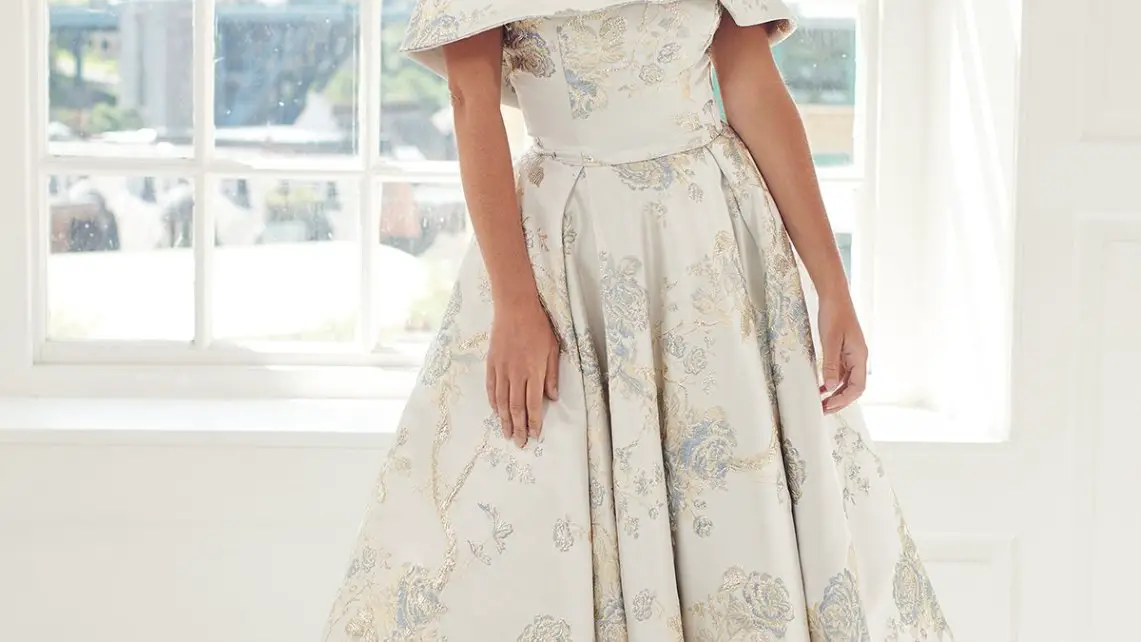
Brocade’s versatility extends far beyond traditional formal wear. Let’s explore where you’ll find this fabric today.
Fashion and Apparel
Wedding Attire: Brocade remains a top choice for bridal gowns, especially in Indian, Chinese, and Middle Eastern weddings. The fabric’s structure helps create those dramatic ball gown silhouettes, while metallic threads add sparkle without additional embellishment.
Evening Wear: Evening gowns, cocktail dresses, and formal separates benefit from brocade’s luxurious appearance. Modern designers are mixing brocade with other fabrics like lace and satin for contemporary looks.
Jackets and Blazers: A brocade jacket instantly elevates any outfit. Paired with jeans or simple dresses, a brocade blazer creates a statement look that’s both bold and sophisticated.
Traditional and Cultural Clothing: From Indian sarees and lehengas to Chinese cheongsams, brocade plays a central role in cultural dress around the world. These garments often feature regional patterns and colors with deep cultural significance.
Accessories: Handbags, shoes, belts, and clutches made from brocade add a touch of luxury to any outfit. These smaller items let you incorporate the fabric without committing to a full garment.
Is Brocade Good for Clothing?
Yes, brocade is excellent for specific types of clothing. It works best for:
- Structured garments that benefit from the fabric’s body
- Special occasion wear where visual impact matters
- Outerwear like jackets and coats
- Garments that don’t require much movement
However, it’s less suitable for:
- Athletic or activewear
- Garments requiring stretch
- Everyday casual clothing
- Hot weather clothing
Is Brocade Good for Dresses?
Absolutely! Brocade makes stunning dresses, particularly for formal events. The fabric’s structure creates beautiful silhouettes in A-line, fit-and-flare, and ball gown styles. For best results, choose styles with princess seams or darts rather than gathered or draped designs.
Home Decor
Upholstery: Brocade’s durability makes it ideal for furniture. It holds up well to regular use and adds elegance to chairs, sofas, and ottomans. The raised patterns create visual interest without needing additional decoration.
Curtains and Drapes: Heavy brocade curtains provide excellent light blocking and insulation. They create a formal, luxurious atmosphere and work particularly well in dining rooms, bedrooms, and formal living spaces.
Throw Pillows: Brocade accent pillows can transform a room. Mix different patterns and colors for an eclectic look, or choose coordinating designs for a more unified aesthetic.
Table Linens: Brocade tablecloths, runners, and placemats elevate special dinners and holiday gatherings. They’re particularly popular for wedding receptions and formal events.
Other Applications
Religious Vestments: Churches and temples use brocade for clergy robes, altar cloths, and ceremonial items. The fabric’s association with reverence and beauty makes it appropriate for religious settings.
Costume Design: Theater, film, and historical reenactors rely on brocade for period costumes. It accurately represents historical garments while being practical for performance.
Corporate and Hospitality: High-end hotels and restaurants use brocade for upholstery, curtains, and decorative elements to create a luxurious atmosphere.
Complete Care Instructions
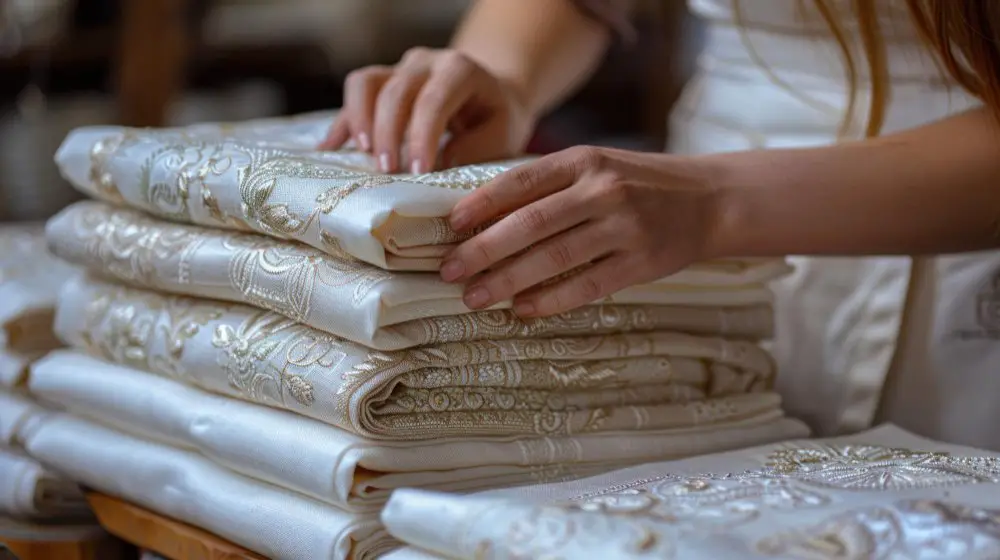
Proper care is essential to keep your brocade looking beautiful for years. Here’s everything you need to know about maintaining this special fabric.
How Do You Care for Brocade Fabric?
Professional Dry Cleaning (Recommended)
For best results, especially with silk or wool brocade, professional dry cleaning is the safest option. The cleaners have the expertise and equipment to handle delicate metallic threads and intricate patterns without damage.
Hand Washing (When Appropriate)
Some cotton and synthetic brocades can be carefully hand washed. Always check the care label first. Here’s how:
- Fill a clean basin with cold or lukewarm water (never hot)
- Add a small amount of gentle, pH-neutral detergent
- Submerge the brocade and gently swish it around
- Let it soak for 15-20 minutes maximum
- Gently squeeze to release dirt (never wring or twist)
- Rinse thoroughly with clean cold water
- Press out excess water by laying flat on a clean towel
- Roll the towel to absorb more water
- Lay flat to dry on a clean, dry surface away from direct sunlight and heat
Does Brocade Shrink When Washed?
Yes, natural fiber brocade (especially cotton and wool) can shrink when washed, particularly in hot water or when machine dried. Silk brocade may also shrink or become distorted. This is why dry cleaning is recommended. If you must wash at home, always use cold water and air dry flat.
Spot Cleaning
For small stains, spot cleaning is often the best approach:
- Test your cleaning solution on a hidden area first
- Use a clean, soft white cloth or sponge
- Dab gently at the stain (never rub vigorously)
- Work from the outside of the stain toward the center
- Blot with a clean, damp cloth to remove cleaning solution
- Allow to air dry completely
DO:
- Read and follow care labels carefully
- Use cold water if washing at home
- Dry flat on a clean surface
- Store in a cool, dry place
- Use acid-free tissue paper between layers when storing
- Iron on low heat with a pressing cloth
- Test cleaning methods on hidden areas first
- Bring to professional cleaners for tough stains
DON’T:
- Use bleach or harsh chemicals
- Wring or twist the fabric
- Tumble dry
- Use hot water
- Iron directly on the fabric (always use a cloth barrier)
- Hang wet brocade (the weight can stretch it)
- Store in plastic bags (use breathable fabric covers)
- Expose to direct sunlight for extended periods
Can I Iron Brocade Fabric?
Yes, but with extreme care. Use the lowest heat setting appropriate for the fiber content. Always iron from the wrong side of the fabric, and place a cotton cloth between the iron and brocade. Never use steam directly on brocade, especially if it contains metallic threads. Press gently rather than sliding the iron across the fabric.
Does Brocade Fray?
Yes, brocade edges fray easily, especially when cut across the grain. The supplementary weft threads can pull loose quickly. Always finish seams properly when sewing with brocade, and consider using pinking shears or serging to minimize fraying during construction.
Storage Tips
Proper storage protects your brocade investment:
- Store in a cool, dry location away from sunlight
- Use breathable garment bags or wrap in clean cotton sheets
- Place acid-free tissue paper between folds to prevent creasing
- For silk brocade, add cedar blocks to deter moths
- Never store in plastic, which traps moisture
- Periodically check stored items for any damage or issues
Buying Guide and Quality Identification
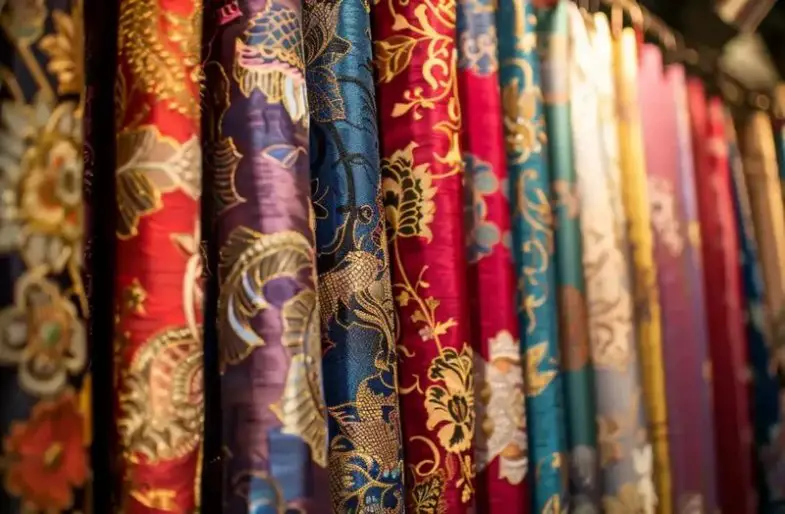
Is Brocade a Costly Fabric?
The answer depends on what type you’re buying. Brocade ranges from quite affordable synthetic versions at $8-15 per meter to extremely expensive silk varieties that can cost $300 or more per meter. Factors affecting price include:
- Fiber content (silk most expensive, synthetic least expensive)
- Pattern complexity (more intricate = higher cost)
- Use of metallic threads
- Production method (handmade vs. machine-made)
- Brand and origin
Budget
$8-25
Synthetic brocade, simpler patterns, good for home decor and costume
Mid-Range
$30-80
Cotton or blended brocade, moderate complexity, suitable for special occasion wear
Luxury
$100-300+
Pure silk, intricate patterns, metallic threads, high-end fashion and bridal
How to Identify Original Brocade Fabric
Not all decorative fabrics labeled as brocade are authentic. Here’s how to tell real brocade from imitations:
1. Check the Back Side
Authentic brocade has a clearly different wrong side with visible floating threads where the supplementary weft creates the pattern. If both sides look nearly identical, it’s likely jacquard but not true brocade.
2. Feel the Texture
Run your hand over the fabric. Real brocade has a three-dimensional quality where the patterns are raised above the base fabric. Printed designs that look like brocade feel flat.
3. Examine the Pattern
Brocade patterns are woven into the fabric. Look closely: you should see the design is created by different colored threads intersecting, not by ink or dye sitting on top of the fabric surface.
4. Test for Fraying
Gently pull at a cut edge. Brocade will show the supplementary weft threads beginning to loosen. Be careful not to damage the fabric, but this test reveals the layered structure.
5. Weight and Drape
Authentic brocade feels substantial and doesn’t drape softly. If it feels too light or flows easily, it might be printed fabric designed to look like brocade.
6. Check for Metallic Threads
If the brocade includes gold or silver elements, look closely at how they’re incorporated. In real brocade, metallic threads are woven in. In imitations, metallic designs might be printed or applied.
What to Look for When Buying
- Even weave: The pattern should be consistent without gaps or irregularities
- Color fastness: Check that colors don’t bleed or rub off
- No snags or pulled threads: Quality control matters
- Appropriate weight: Should match your intended use
- Clear care instructions: Reputable sellers provide proper care information
- Fabric composition: Should be clearly labeled
Sewing with Brocade
Working with brocade can be challenging, but these tips will help you achieve professional results.
Learn essential techniques for sewing with brocade, including cutting, marking, and finishing methods to prevent fraying.
Before You Start
Pre-treatment: Most synthetic brocades don’t need pre-washing. However, if you’re working with cotton or silk and plan to wash the finished garment, pre-treat the fabric according to its fiber content.
Pattern Selection: Choose patterns with simple, structured designs. Avoid styles with gathers, drapes, or bias cuts. Look for patterns specifically recommended for brocade or heavyweight fabrics.
Lining: Always plan to line brocade garments. The lining hides the messy wrong side, makes the garment more comfortable, and helps it last longer.
Cutting Brocade
- Use sharp fabric scissors or a rotary cutter
- Cut with the pattern running in one direction for best results
- Add extra seam allowance (at least 5/8 inch) because edges fray easily
- Mark pattern pieces on the wrong side with tailor’s chalk
- Consider the pattern placement so designs align attractively
Sewing Techniques
Needle Selection: Use a sharp universal needle, size 14/90 or 16/100 depending on fabric weight.
Thread: Match your thread to the base fabric. Use polyester thread for synthetic brocade and silk or cotton-covered polyester for natural fibers.
Stitch Length: Use a slightly longer stitch length (3.0mm) to prevent puckering.
Seam Finishing: Finish seams immediately after sewing to prevent fraying. Options include:
- Serging/overlocking (best option)
- French seams (for lighter weight brocade)
- Hong Kong finish (professional looking)
- Pinked edges (quick but less durable)
Pressing: Use low heat and always press from the wrong side with a pressing cloth. Test on a scrap first.
Common Challenges and Solutions
Fraying: Apply a thin line of fray check or clear nail polish to cut edges before sewing. Work quickly because the edges deteriorate fast.
Bulk in Seams: Grade seam allowances by trimming them to different widths. This reduces bulk at seams and helps the garment lie flat.
Needle Marks: Once you make a hole in brocade, it’s permanent. Pin only within seam allowances, never in the body of the fabric.
Pattern Matching: For patterns with obvious repeats, buy extra fabric to allow for matching at seams.
Interfacing
If your pattern calls for interfacing, use sew-in interfacing, never fusible. The heat required for fusible interfacing can damage brocade, especially if it contains metallic threads or is made from synthetic fibers.
Cultural Significance Around the World
Which Country Made Brocade?
Brocade originated in China during the Warring States period (475-221 BC), making it one of the oldest continuously produced luxury textiles. However, the fabric quickly spread along trade routes and was adapted by cultures worldwide, each developing their own distinctive styles.
What Country is Brocade From?
While China invented brocade, it’s not exclusive to any single country today. Major brocade-producing regions include:
India
Which City is Famous for Brocade? Varanasi (also called Benares or Banaras) in Uttar Pradesh is the undisputed capital of Indian brocade. Banarasi brocade, featuring intricate gold and silver zari work, has been produced here for over 2000 years. The city’s weavers create brocades for wedding sarees, lehengas, and ceremonial wear.
Other important Indian brocade centers include:
- Ahmedabad, Gujarat (known for silk brocade)
- Bangalore, Karnataka (producing both traditional and contemporary designs)
- Paithan, Maharashtra (famous for Paithani sarees with peacock and lotus motifs)
Are Brocade and Banarasi the Same?
Not exactly. Banarasi is a specific style of brocade from Varanasi, India. All Banarasi fabric is brocade, but not all brocade is Banarasi. Banarasi brocade is distinguished by its Mughal-influenced designs, extensive use of gold and silver threads, and specific weaving techniques passed down through generations.
Is Brocade an African Print?
No, brocade is not an African print. African prints (like Ankara or Dutch wax print) are printed cotton fabrics with bold, colorful designs. However, brocade is produced and used in various African countries for special occasions, particularly for traditional wedding attire and ceremonial garments. West African countries have embraced brocade in their fashion traditions, often called “Guinea brocade” when featuring specifically African color combinations and patterns.
China
Chinese brocade continues a tradition spanning millennia. Famous varieties include:
- Song Jin (Song Brocade): From Suzhou, featuring delicate patterns
- Yun Jin (Cloud Brocade): From Nanjing, once reserved for imperial robes
- Li Brocade: From Hainan Island’s Li minority, now gaining international fashion attention
What Cultures Use Brocade?
Brocade plays an important role in cultures worldwide:
- Middle East: Persian and Turkish brocades feature geometric and floral patterns for traditional clothing and home textiles
- Japan: Nishijin-ori brocade from Kyoto is used for kimonos and obis
- Europe: Italian brocade remains prestigious for ecclesiastical vestments and luxury fashion
- Southeast Asia: Thai and Indonesian brocades feature in traditional ceremonial dress
- Latin America: Guatemala produces brocade on backstrap looms with indigenous Mayan designs
Religious and Ceremonial Use
Across cultures, brocade’s luxurious appearance makes it appropriate for religious settings. It’s used for:
- Christian church vestments and altar cloths
- Buddhist monk robes in certain traditions
- Islamic prayer rugs and decorative elements
- Hindu temple decorations and deity clothing
Frequently Asked Questions
Conclusion
Brocade fabric stands at the intersection of history and modernity, tradition and innovation. From its origins in ancient China to its current revival in 2025 fashion, this remarkable textile has proven its lasting appeal across cultures and centuries.
The global brocade market’s projected growth to $1.5 billion by 2025 reflects more than just numbers. It represents a renewed appreciation for craftsmanship, texture, and materials that tell a story. Whether you’re drawn to brocade for a wedding gown, a statement jacket, or home decor, you’re participating in a tradition that connects you to thousands of years of textile artistry.
Understanding Brocade
Remember that brocade is defined by its raised, woven patterns created through supplementary weft threads. It’s not just printed fabric or embroidery, but a unique weaving technique that creates three-dimensional designs. While all brocade is jacquard, not all jacquard is brocade. The distinction lies in those characteristic raised patterns and the clearly different wrong side showing floating threads.
Choosing the Right Brocade
Your choice depends on your needs and budget:
- For special occasions: Silk brocade offers unmatched luxury
- For everyday elegance: Cotton or synthetic brocade provides beauty with practicality
- For cold weather: Wool brocade adds warmth and style
- For sustainability: Look for organic fibers or recycled synthetic options with proper certifications
Care and Maintenance
Proper care extends your brocade’s life significantly. Professional dry cleaning remains the safest option for most brocade, especially silk and wool varieties. If you must wash at home, use cold water, gentle detergent, and air dry flat. Never use bleach, hot water, or machine dryers. Always iron on low heat with a pressing cloth barrier, working from the wrong side.
Style Considerations
Brocade works beautifully for structured garments, formal occasions, and statement pieces. Choose patterns and colors that complement your style, but remember that brocade is meant to stand out. Keep the rest of your outfit simple when wearing brocade to let the fabric shine.
For home decor, brocade adds instant elegance. Whether as upholstery, curtains, or accent pillows, this fabric transforms ordinary spaces into sophisticated environments.
Key Takeaways for Success with Brocade
- Quality Recognition: Learn to identify authentic brocade by checking the wrong side for floating threads and feeling for raised patterns
- Sustainability Matters: Choose natural fibers when possible and look for OEKO-TEX, GOTS, or GRS certifications
- Proper Care is Non-Negotiable: Dry clean when possible, hand wash carefully if needed, and never compromise on storage conditions
- Know Your Uses: Brocade excels in structured garments and formal settings but isn’t suitable for stretchy, casual, or athletic wear
- Budget Wisely: Prices range from $8 to $300+ per meter. Know what you’re paying for and choose quality appropriate to your project
- Cultural Awareness: Appreciate brocade’s rich cultural heritage, from Chinese origins to Indian Banarasi traditions
- Follow Trends Smartly: Brocade is trending in 2025, but choose timeless designs that won’t look dated quickly
- Sewing Success: If making your own garments, use sharp tools, finish seams immediately, and always line your creations
Looking Forward
The future of brocade looks bright. Innovations in sustainable production, combined with traditional craftsmanship and modern design sensibilities, are creating exciting new possibilities. Whether through eco-friendly dyes, recycled fibers, or digital Jacquard technology, brocade continues to evolve while maintaining its essential character.
As you explore brocade for your own projects, remember that you’re working with a fabric that has dressed emperors, adorned palaces, and marked life’s most important moments for thousands of years. That history doesn’t make brocade precious or untouchable. Instead, it reminds us that beautiful, well-crafted materials enrich our lives in ways that transcend mere utility.
Whether you’re planning a wedding outfit, updating your home decor, or simply appreciating textile artistry, brocade offers something special. It’s a fabric that demands attention and rewards care, providing beauty and elegance that never goes out of style.
For more information on fabric care and selection, explore our guides on silk care, cotton care, and washing different fabric types.
